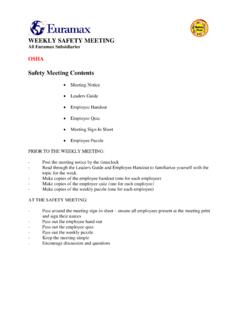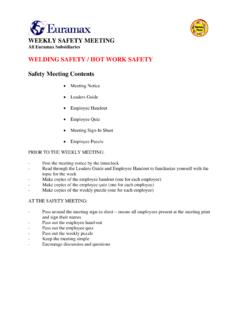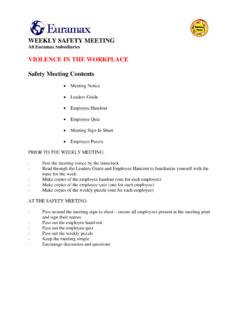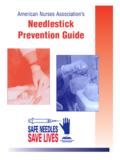Transcription of WEEKLY SAFETY MEETING BLOODBORNE …
1 WEEKLY SAFETY MEETING All Euramax Subsidiaries BLOODBORNE pathogens SAFETY MEETING Contents MEETING Notice Leaders Guide Employee Handout Employee Quiz MEETING Sign-In Sheet Employee Puzzle PRIOR TO THE WEEKLY MEETING : - Post the MEETING notice by the timeclock - Read through the Leaders Guide and Employee Handout to familiarize yourself with the topic for the week - Make copies of the employee handout (one for each employee) - Make copies of the employee quiz (one for each employee) - Make copies of the WEEKLY puzzle (one for each employee) AT THE SAFETY MEETING .
2 - Pass around the MEETING sign-in sheet ensure all employees present at the MEETING print and sign their names - Pass out the employee hand-out - Pass out the employee quiz - Pass out the WEEKLY puzzle - Keep the MEETING simple - Encourage discussion and questions WEEKLY SAFETY MEETING NOTICE THIS WEEK, OUR SAFETY MEETING WILL COVER BLOODBORNE pathogens TIME: _____ DATE: _____ PLACE: _____ WEEKLY SAFETY MEETING All Euramax Subsidiaries Leaders Guide Page 1 BLOODBORNE pathogens EURAMAX PROCEDURE REFERENCE: : BLOODBORNE Pathogen Program MEETING OBJECTIVE: Contact with BLOODBORNE pathogens is a potentially life-threatening hazard one that your employees may someday face on the job.
3 OSHA s BLOODBORNE pathogens standard requires all employers to take safeguards to protect workers against these serous health hazards. There are strict training requirements for those employees whose job responsibilities make it likely that they will be exposed to blood or bodily fluids. But raising awareness for all employees is important to keep them safe in the event of an injury or illness that involves blood or bodily fluids.
4 The purpose of this MEETING is to review the basics of BLOODBORNE pathogen SAFETY with your employees and teach them the precautions they can take when faced with these hazards. It is also designed to dispel myths and calm unfounded fears about the transmission of the viruses that cause AIDS and hepatitis B. OSHA s BLOODBORNE pathogen standard is often one of the Top 10 most frequently violated standards, with penalties in the hundreds of thousands of dollars.
5 The risk of contacting hepatitis B from exposure to infected blood may be as high as 30%. MEETING PREPARATION: Read the Euramax procedure, understand the contents, and ensure compliance. Consider possible work situations that could expose employees to BLOODBORNE pathogens . Be prepared to discuss these during the MEETING . Review the employee handout to see if there are any other materials you wish to bring to the MEETING . Use a flip chart during the discussion to write key points and employee responses.
6 This technique visually reinforces your instruction. MATERIALS CHECKLIST: Flip chart and marking pens WEEKLY SAFETY MEETING All Euramax Subsidiaries Leaders Guide Page 2 BLOODBORNE pathogens MEETING INTRODUCTION Today, we re going to talk about SAFETY in regard to BLOODBORNE diseases. You ve all heard of HIV and probably most of you know that HBV is the hepatitis B virus. You know that these viruses can kill. What we re going to discuss is how to protect yourself against contact with these viruses in the workplace.
7 Simply defined, BLOODBORNE pathogens are microorganisms that are transmitted through the blood and other body fluids and are capable of causing disease. The two most high-profile pathogens are HIV (human immunodeficiency virus) and HBV (hepatitis B virus). Awareness about BLOODBORNE pathogens has grown in recent years as sports heroes and movie stars have contracted HIV, along with thousands of ordinary citizens male and female, old and young, black and white. And HBV, which is more infectious than HIV, is also becoming a household word.
8 Most often, exposure to these viruses occurs outside the workplace. But not always. Question: How are BLOODBORNE pathogens transmitted? Answer: The viruses can only be transmitted through direct contact with infected blood or other body fluids. Question: What are the most common means of transmission? Answer: Contact between contaminated blood (or other body fluids) and the eyes, nose, mouth, or breaks in the skin Sexual intercourse with an infected partner Sharing needles with an infected person, usually involving drug use Transmission from infected mother to child before, at, or after birth Blood transfusions (although with current screening techniques, this type of transmission is very rare)
9 WEEKLY SAFETY MEETING All Euramax Subsidiaries Leaders Guide Page 3 BLOODBORNE pathogens Question: There are many myths about these viruses. What are some of the ways that people incorrectly assume the viruses can be transmitted? Answer: Casual contact with an infected person. Simply working alongside someone who has the virus presents no health risk. Neither does touching an infected person, shaking hands, or even hugging. Sharing equipment, bathrooms, telephones, cafeterias, or water fountains with an infected person.
10 Coughing or sneezing. Although the virus may be carried in mucous, it is often in very low concentrations. And, remember, the virus can only infect a person if it gets into his or her bloodstream. Explain that these viruses are not easily transmitted. HIV, in particular, does not live very long outside the human body. Even when someone comes into direct contact with blood from an infected person, the chances of contracting HIV or HBV are relatively small (although the risk is greater for HBV).

















